
Subscribe to stay informed, inspired and involved.
As recently reported, First Trust has announced the conversion of four of its closed-end funds (CEFs) into exchange-traded funds (ETFs), encompassing assets totaling $1.4 billion1. What the report did not mention is that Saba Capital, the most aggressive activist investor today, has established significant stakes in three of the CEFs undergoing conversion and has filed 13D forms for each. These conversions, disclosed on Nov. 1, 2023, are notably timed following the increased stakes acquired by Saba between February and September of this year.
Saba’s ownership position in these CEFs is as follows:
| Fund Name | Saba's Ownership | Latest 13D/A Filing |
|---|---|---|
| First Trust MLP and Energy Income (FEI) | 7.5% | 9/5/2023 |
| First Trust Energy Infrastructure (FIF) | 6.2% | 4/12/2023 |
| First Trust New Opportunities MLP & Energy (FPL) | 8.4% | 9/27/2023 |
Additionally, Bulldog Investors, the second leading CEF activist, holds a 6.9% stake in the First Trust Dynamic Europe Equity Income Fund (FDEU) as of April 12, 2023, according to a 13D/A filing, and has played a significant role in its conversion into an ETF2. Bulldog initiated legal action against First Trust's control share provisions in FDEU, but subsequently withdrew the lawsuit following First Trust's retraction of the control share amendment and the announcement of the fund's conversion.
OUR TAKE
This all means that five First Trust CEFs have either converted or are in the process of converting into ETFs, and the two leading CEF activists appear to have driven all these conversions. Among the recent fund conversions announced by First Trust, one notable instance is the First Trust Energy Income and Growth (FEN). This CEF is distinctive because it does not have any activist ownership. One explanation for FEN being included with the other conversions is that the four CEFs undergoing conversions, including FEN, are energy sector funds, and First Trust may have added this fund to avoid future activist challenges.
The conversion of CEFs into ETFs, while not a widespread practice, has been observed in a few notable instances led by select fund managers. Typically, CEFs are more often converted into open-end mutual funds. Given the similarity in trading mechanisms, ETFs can be an attractive option for those familiar with CEFs. However, for firms like Saba and Bulldog, which often target CEFs with substantial discounts to NAV - a characteristic less common in ETFs - the preference between the two may not be straightforward. The potential shift towards more ETF conversions, if it indeed becomes a trend, could lead to interesting changes in the investment landscape, especially in how these activist firms approach their strategies given the different pricing dynamics of ETFs.
As the investment landscape continues to evolve, the traditional roles of ETFs and CEFs are being redefined. Historically passive ETFs are increasingly embracing active management, blurring the lines that once distinctly separated them from actively managed CEFs. First Trust, with its diversified approach encompassing ETFs, CEFs, and Unit Investment Trusts (UITs), stands at the forefront of this paradigm shift. This dynamic transformation, fueled by the growing activism in the CEF space, not only hints at a potential uptick in CEF to ETF conversions but also signifies a broader rethinking of investment strategies and fund structures. As we observe these developments, they offer valuable insights for investors and fund managers, particularly those involved with CEFs and ETFs, underscoring the need for adaptability and a nuanced understanding of these evolving fund dynamics.
This publication is part of the 'Views on the News' series, providing crucial insights for fund managers navigating these turbulent times.
1. “First Trust to Convert $1.4B in CEFs to ETFs,” Ignites, 11/3/23.
2. “’This is Not Venezuela:’ Activist Seethes at Directors over Meeting Quorum after Dropping Lawsuit,” BoardIQ, 10/31/23.
Summary
Author

Alex Pulisic
Managing Director
New York
alex.pulisic@sodali.com
Related Reports
ETF Conversions & Multiple Share Class Structures: Governance Considerations for Fund Boards
24 April 2025
Views on the News: NYSE Withdraws Annual Meeting Exemption — Shareholder Rights Prevail
25 March 2025
Views on the News: SEC Weighs Elimination of Annual Meeting Requirement for Closed-End Funds
05 December 2024